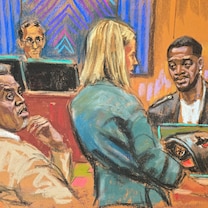Face Transplant Patient Getting Back to Normal Life
May 25, 2006 — -- In June 2005, just weeks after her dreadful injury, Isabelle Dinoire crossed the doorstep at the University Hospital in Amiens
After taking a handful of sleeping pills to allegedly end her life, Dinoire passed out and was attacked by her own dog. When she regained consciousness, she found out she had lost half her face -- no more lips, no nose, no chin.
"When I came to, there was blood on the ground and I tried to get up, to stand up, but I couldn't manage. I wasn't aware how bad a state I was in, only that I had blood on my arms. I tried to light a cigarette but I never got it to light," Dinoire said.
For a long time, doctors looked on helplessly at her disfigurement. But then a reconstructive specialist at the hospital said he had an idea.
"We all looked at each other and thought the same thing, and though nobody dared pronounce the word 'transplant.' It was kind of staring us in the face," said surgeon Dr. Sylvie Testelin.
A facial disfigurement is one of the most traumatic injuries a person can face, say many doctors.
"The lack of a face is very powerful narcissistic threat, it means we lose the part of our identity, that's to say, the image we constantly see of ourselves, an image with all its ups and downs," said psychiatrist Dr. Gabriel Burloux.
After her injury, Dinoire always wore a mask to keep people from seeing the hole where her face used to be.
"Even in the corridors the mask is always on. Even when I go for a shower the mask is always on," Dinoire said. "The first time I went outside, in some ways I was happy to be going out but in other ways I was frightened to leave the hospital. At the start, I cried every time I went out.
"Some people don't say anything out of the ordinary; they say hello, they talk. Other people look and shrink back. In the shops, some people even hide out of the way."
In hospitals all over the world, disfigured patients are treated using the same technique: Strips of muscle and skin are taken from the patient and used to reconstruct something that over the course of many successive operations starts to resemble a face.
Dr. Benoit Lengele said the results were usually disappointing.
"We could have reconstructed something like a face with the look of a jigsaw puzzle, with scars all over, on the forehead, on the cheeks as well no doubt; but it would have been something stilted, something deprived of any mobility or the ability to express feelings, and deprived also of its sensitivity, its sensations."



